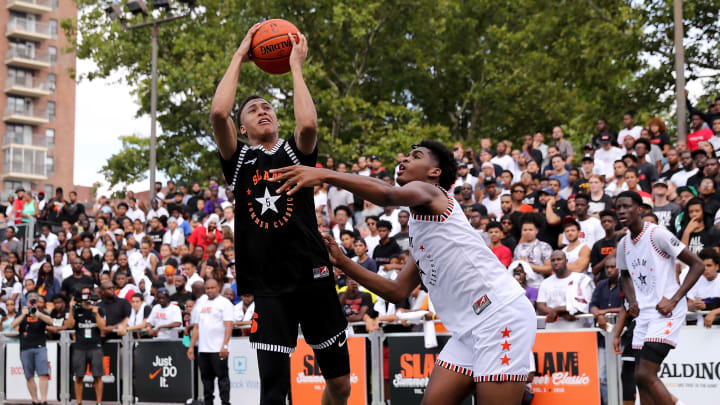R.J. Hampton, Amateurism and the Shifting Path to the NBA

If there’s a big takeaway from a noteworthy week in the world of amateur and college basketball—and really, it’s not that big an inference whatsoever—it’s that, yes, young players would like to be paid for their talent. Projected top-five 2020 draft pick R.J. Hampton is heading to New Zealand instead of Kansas. A flood of underclassmen opted to remain in the 2019 draft, many of whom won’t be among the 60 draftees on June 20. Players are forgoing traditional pathways to jump-start their pro careers. It’s not the death of college basketball, but it’s quite clear the landscape is shifting.
As has been reported for quite a while now, there’s a widespread understanding among teams that the NBA will successfully lower the age limit, the primary impetus to do so coming not from teams or the Players Association, but from the commissioner himself. Of course, these talks have been prolonged, and the feeling continues to be that the 2022 draft will be the first to allow 18-year-olds back into the league. Adam Silver continues to be proactive about change, and the NBA’s first formal proposal came in February. It’s a give-and-take process, but it’s coming, one way or another.
Future first-round picks were already coming at a premium via trade, perhaps even more so now that the league’s lottery reform changes are evidently working. The Pelicans, Grizzlies and Lakers’ success within the new odds should make mid-tier teams even more hesitant to part with unprotected selections, and conversely, make the prospect of acquiring draft capital more enticing to teams offloading talent. There’s not a ton of excitement at the moment about the 2020 draft, but the 2021 class looks much deeper. The prospect of the age limit changing and producing a “double draft” 2022 makes those picks potentially even more coveted. It’s something to monitor as the draft and offseason draw closer.

The decisions made by Hampton and the swath of fringe-draftable prospects point to the fact that the age-limit change will be a welcome one—while college basketball may lose something off the top when it comes to elite talent, players will ultimately have no hard barriers to a professional career. It doesn’t mean we’ll see every kid rush into the pros, but at least they’ll have a choice. The NBA tries to give the best feedback possible to players who may or may not be good enough for the league, and those guys get to make their decisions. If the NCAA wants more of them back, allowing players to profit from their likenesses might be a start. But as Hampton’s choice illustrates, the world where all players dream of Final Fours and playing for legendary coaches is long gone.
From an NBA perspective, that paradigm shift is totally fine. The funneling of amateur talent into the league is still, more or less, a meritocracy. The power to decide who is or isn’t going to be an NBA player falls into the hands of the 30 teams, who spend time and resources to evaluate those players year-round. That’s never going to change. If this year’s stay-or-go deadline tells us anything, it’s that players will ultimately choose what they feel is best. That’s basic self-interest at work. And when going back to school isn’t going to boost your stock, it can make total sense to turn pro. Players who really want to develop will seek the best environments to do that. Of course, the additional time spent on your craft, and the money you can make legally doesn’t hurt. Going undrafted isn’t a scarlet letter, and no matter how angry a college fan base might get, it doesn’t always mean a player is making the wrong decision, either.
Having a deeper rookie talent pool that trickles into the G League certainly isn’t a bad thing for the NBA’s interests. Although no high school player has chosen their professional path option over college yet, the G League’s level of play will undoubtedly be bolstered by the wave of sophomores and juniors who will go undrafted, ending up on two-way contracts and in training camps, then with their team’s affiliate. The aim is to further increase salaries, and the G League is on its way to having a direct feeder program for every NBA team. So when the age limit lifts, there should ideally be a more stable pathway for prospects to develop domestically, be paid, and do so with an understanding of what it might take to reach the league. There have been rumors that teams might be granted a third two-way contract slot at some point in the future. The market to secure top undrafted guys will be stronger than ever in a few weeks, and it should only grow going forward.
While there’s nothing particularly shocking or conclusive to cull from this wave of decisions—not every future All-American will follow Hampton overseas, and soon enough, they won’t have to—right now it’s somewhat obvious which direction things are headed, NCAA notwithstanding. Ultimately, the hope is that it can benefit everyone. And as long as players and teams are empowered to make their own decisions, the market should take care of itself.
